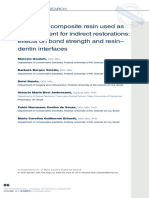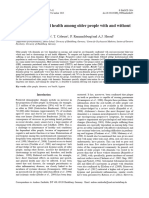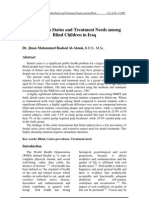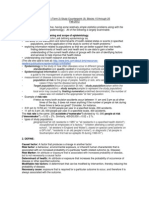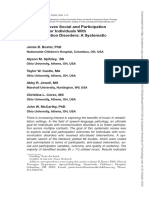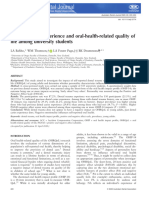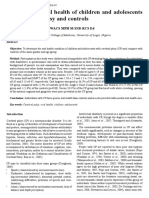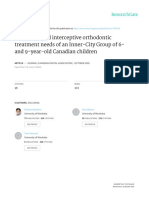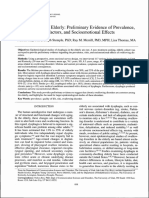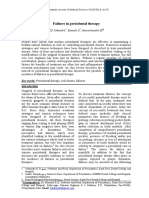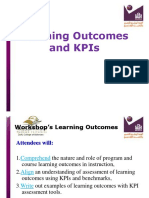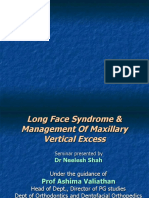Journal of Dental Research
Journal of Dental Research
Uploaded by
A'Rahman KassemOriginal Description:
Original Title
Copyright
Available Formats
Share this document
Did you find this document useful?
Is this content inappropriate?
Report this DocumentCopyright:
Available Formats
Journal of Dental Research
Journal of Dental Research
Uploaded by
A'Rahman KassemCopyright:
Available Formats
Journal of Dental Research http://jdr.sagepub.
com/
Variations in the Social Impact of Oral Conditions Among Older Adults in South Australia, Ontario, and North Carolina
G.D. Slade, A.J. Spencer, D. Locker, R.J. Hunt, R.P. Strauss and J.D. Beck J DENT RES 1996 75: 1439 DOI: 10.1177/00220345960750070301 The online version of this article can be found at: http://jdr.sagepub.com/content/75/7/1439
Published by:
http://www.sagepublications.com
On behalf of:
International and American Associations for Dental Research
Additional services and information for Journal of Dental Research can be found at: Email Alerts: http://jdr.sagepub.com/cgi/alerts Subscriptions: http://jdr.sagepub.com/subscriptions Reprints: http://www.sagepub.com/journalsReprints.nav Permissions: http://www.sagepub.com/journalsPermissions.nav Citations: http://jdr.sagepub.com/content/75/7/1439.refs.html
Downloaded from jdr.sagepub.com by guest on March 20, 2011 For personal use only. No other uses without permission.
J Dent Res 75(7): 1439-1450, July, 1996
Variations in the Social Impact of Oral Conditions Among Older Adults in South Australia, Ontario, and North Carolina
G.D. Sladel*, A.J. Spencer2, D. Locker', R.J. Hunt', R.P. Strauss', and J.D. Beck'
1Department of Dental Ecology, School of Dentistry, The University of North Carolina, Chapel Hill, North Carolina 27599-7450, USA; 2Department of Dentistry, The University of Adelaide, South Australia 5005, Australia; 3Community Dental Services Research Unit,
University of Toronto, 124 Edward St., Toronto, ON M5G 1G6 Canada; *to whom correspondence should be addressed
Abstract. Previous studies among older adults have demonstrated that oral disease frequently leads to dysfunction, discomfort, and disability. This study aimed to assess variations in the social impact of oral conditions among six strata of people aged 65 years and older: residents of metropolitan Adelaide and rural Mt Gambier, South Australia; residents of metropolitan Toronto-North York and non-metropolitan Simcoe-Sudbury counties, Ontario, Canada; and blacks and whites in the Piedmont region of North Carolina (NC), United States. Subjects were participants in three oral epidemiological studies of random samples of the elderly populations in the six strata. Some 1,642 participants completed a 49-item Oral Health Impact Profile (OHIP) questionnaire which asked about impacts caused by problems with the teeth, mouth, or dentures during the previous 12 months. The percentage of dentate people reporting impacts fairly often or very often was greatest among NC blacks for 41 of the OHIP items. Two summary variables of social impact were used as dependent variables in bivariate and multivariate least-squares regression analyses. Among dentate people, mean levels of social impact were greatest for NC blacks and lowest for NC whites, while people from South Australia and Ontario had intermediate levels of social impact (P < 0.01). Missing teeth, retained root fragments, root-surface decay, periodontal pockets, and problem-motivated dental visits were associated with higher levels of social impact (P < 0.05), although there persisted a two-fold difference in social impact across the six strata after adjustment for those factors. Among edentulous people, there was no statistically significant variation in social impact among strata. The findings suggest that there are social and cultural factors influencing oral health and its social impact, and that those factors differ most between dentate blacks and whites in NC.
Key words: oral health, social impact, geriatric dentistry.
Received May 22, 1995; Accepted February 1, 1996
Introduction
Population surveys of oral health in different countries have provided valuable insight into the process of oral disease (Loe, 1978), effects of dental services (Arnljot et al., 1985), and the behaviors and attitudes that influence oral health (Davis, 1987). The comparison of disease levels among distinct populations is an epidemiological technique which is useful for our understanding of the distribution and determinants of disease. The oral health database maintained by the World Health Organization (Pilot and Miyazaki, 1994) and two international conferences examining declining dental caries levels among children (Glass, 1982; Naylor, 1994) represent applications of that epidemiological technique to oral health. International comparisons of oral health survey data have identified the contributions of risk factors and preventive strategies to disease levels, and also highlighted the effects of social and cultural factors on attitudes and behaviors concerning oral health and dental care. During the last decade, oral epidemiologists and social scientists have broadened their assessments of oral conditions to incorporate concepts of dysfunction, discomfort, and disability. This represents a shift of interest from strictly clinical aspects of disease, such as caries and periodontal destruction, to a broader examination of the social impact of disease on daily life (Locker, 1988). For example, researchers have found that oral disease and dental visits result in substantial levels of work-loss and days off school within the US population (Reisine, 1985; Gift et al., 1992). More specific impacts include oral pain, reported by 39% of the adult population in Toronto (Locker and Grushka, 1987), and difficulty chewing, reported frequently among edentulous residents of a nursing home in the UK (Smith and Sheiham, 1979). This broadened scope of oral epidemiology is consistent with current concepts of general health (World Health Organization, 1980) which recognize disability and handicap as distinct outcomes of disease and impairment. The dimensions of social impact
1439
Downloaded from jdr.sagepub.com by guest on March 20, 2011 For personal use only. No other uses without permission.
1440
Slade et al.
be summarized as follows:
J Dent Res 75(7) 1996
used in oral epidemiologic studies also conform closely with the continuum of impairment, function, disability, and opportunity that has been used to define oral-health-related quality of life (Gift and Atchison, 1995). Investigations into the social impact of oral conditions among older adults have revealed a range of impacts including oral pain, difficulty chewing, embarrassment, and social isolation (Smith and Sheiham, 1979; Atchison and Dolan, 1990; Fiske and Watson, 1990; Gilbert et al., 1993). Those studies demonstrate that older adults are likely to experience numerous social impacts because of their accumulated experience of tooth loss, caries, and periodontal destruction. The World Health Organization's (WHO) first international collaborative study reported information about oral pain. Sore gums were reported by 14 to 32% of people, sore mouth by eight to 20%, and toothache by 14 to 39%, with much of the variation being related to levels of edentulism within the five nations reported (Davis, 1987). While the findings from the WHO study demonstrate international variations in oral disease and its social impact, the study did not assess the full range of impacts proposed by other researchers (Sheiham and Croog, 1981; Reisine, 1981; Nikias, 1985; Locker, 1988). In addition, the previous international comparisons have not commented on relationships between oral health status and its impact on well-being, or on whether those relationships were consistent among countries. One reason for these omissions has been the historical lack of detailed survey instruments to measure the social impact of oral conditions. It has been only in the last decade that such instruments have been tested by psychometric techniques (Cushing et al., 1986; Rosenberg et al., 1988; Gooch et al., 1989; Atchison and Dolan, 1990; Slade and Spencer, 1994a; Locker and Miller, 1994). In preliminary results reported from the second WHO international collaborative study, aspects of social impact included social function, physical function, physical appearance, and denture disorders (World Health Organization, 1995). The aim of this study was to assess variations in the social impact of oral disease reported by representative samples of older adults in six strata from three countries: Australia, Canada, and the United States. It was hypothesized that any differences in social impact among the strata would be related to cultural differences and to underlying variations in clinical oral health status and use of dental services.
* stratified random samples of community-dwelling adults were selected from regions within a state/province of each country; * subjects completed an Oral Health Impact Profile questionnaire (Slade and Spencer, 1994a) which asked 49 questions about dysfunction, discomfort, and disability caused by oral conditions; * subjects also completed a standard oral examination which followed the National Institute of Dental Research (NIDR) protocol for oral epidemiological surveys of adults (National Institute of Dental Research, 1987); and * the analysis compared the frequency of individual social impacts among strata, and least-squares regression analysis was used to assess differences in summary scores of social impact after adjustment for oral status and dental visits.
Source of subjects
For each parent study, older adults representative of three respective non-institutionalized populations were sampled from two groups, providing a total of six strata for this analysis. The details of sampling are summarized in Table 1 and described below. In South Australia, the two groups were defined by Adelaide, the state capital city with a population of 1.1 million people, and Mt Gambier, a rural city with a population of 26,000 in the state's southeast. For both cities, the sampling frame was the state electoral database, which is a compulsory register for Australian citizens aged 18 years or older. Within each city, people were sampled from age, sex, and locality strata to provide approximately equivalent numbers of subjects in age and sex categories. To avoid over-enumerating edentulous people, we selected a subsample of edentulous people within Adelaide. However, in Mt Gambier, all edentulous people were excluded, because the parent study was interested in assessing caries experience in that non-fluoridated city. Sampled people were visited by trained interviewers who explained the study, sought participation, and completed a 72question interview at the household. The questionnaire asked about oral health status, use of dental services, general health, and socio-demographic factors. Following the interview, participants were issued a self-complete OHIP questionnaire to be returned by mail, and they were invited to take part in an oral examination, scheduled at a nearby public clinic or at the person's household. Up to two reminder notices were sent to people who failed to return a completed OHIP questionnaire. Materials and methods The collection of OHIP data for this collaborative study took place between May, 1991, and March, 1992. In Ontario, the two groups were defined by the metropolitan This paper reports cross-sectional findings from three parent cities of Toronto and North York, which have a combined studies of older adults in Australia, Canada, and the United population of 1.1 million, and by the non-metropolitan States. Investigators from the parent studies collaborated on the communities of Simcoe and Sudbury in the province's central design, collection, and analysis of data concerning social impact. and northwest region, which have a combined population of Prior publications have examined the social impact of oral 230,000. For each locality, older adults were selected by conditions within each parent study (Locker and Slade, 1993; random-digit dialing of households with telephones, and one Slade and Spencer, 1994b; Hunt et al., 1995), but have not person was selected at random within any household which compared results among the populations. The four sections that had a use only. No aged without permission. and methods which can follow provide details of the materialsfrom jdr.sagepub.com by guest on March 20, 2011 For personalresident other uses 50+ years. Selected people were asked 12 Downloaded
j Dent Res 75(7) 1996
Social Impact of Oral Conditions
1441
general questions about dental health during the telephone contact, and subsequently they were asked to participate in the study by having an interviewer and examiner team visit their household. The interviewer and examiner team asked questions about oral health status, use of dental services, general health, and socio-demographic factors, and they also conducted an oral examination. The timing of issuing OHIP questionnaires differed between the two Ontario locations. In Simcoe-Sudbury, where interviews and examinations were conducted in 1991, OHIP questionnaires were left at participants' households immediately after the interview and examination. However, in Toronto and North York, where interviews and examinations were conducted in 1989-90, the OHIP questionnaire was mailed to participants' households a year after interviews and examinations (that is, during 1990-91). The one-year interval in Toronto was necessary because the collaborative project did not begin until 1991, by which time baseline interviews and examinations in Toronto and North York had been completed. For both Ontario strata, up to two reminder notices were sent to people who did not return an OHIP questionnaire. In North Carolina, the two groups were defined by race: black and white. Subjects were selected at random from participants in a larger study of general health in the five contiguous counties in the state's Piedmont region, which has a population of 310,000. For the study of general health, entitled the Piedmont 65+ Study of the Elderly, a clustered random sampling technique enumerated 5,400 households from which subjects were selected. One person per household was selected, and 4,500 agreed to participate. In 1988, subsamples of participating blacks and whites were selected for the Piedmont 65+ Dental Study. Sampling aimed at obtaining similar numbers of people in each race group and dentate people were oversampled with the intention of obtaining approximately 800 dentate and 200 edentulous participants. The baseline data collection for the Piedmont 65+ Dental Study took place in 1988, when 1008 people were interviewed and examined. The collection of OHIP data for the collaborative study took place during 1991 at the time of the three-year follow-up for the Piedmont 65+ Dental Study. At that time, participants were visited at their homes by a dentist interviewer/examiner and a recorder who administered a structured interview about oral health status, use of dental services, general health, and sociodemographic factors. They conducted an oral examination and left an OHIP questionnaire to be self-administered. Up to two reminder notices were sent to people who did not return the OHIP questionnaire by mail.
OHIP questionnaires
The OHIP questionnaire used at each collaborating location contained 49 questions about impacts attributed to oral conditions. The development, reliability, and validity of the questionnaire has been reported previously (Locker and Slade, 1994; Slade and Spencer, 1994a). Each question asked, "How often during the last 12 months have you had [impact item] because of problems with your teeth, mouth or dentures?" The 49 impact items encompassed seven conceptual dimensions of impact: functional limitation (for example, difficulty chewing
foods), physical pain (for example, toothache), psychological discomfort (for example, self-consciousness), physical disability (for example, avoiding foods), psychological disability (for example, concentration affected), social disability (for example, being less tolerant of others), and handicap (for example, being totally unable to function). The dimensions were intended to reflect a hierarchy of increasingly complex and disruptive impacts, with the first three dimensions consisting of impacts apparent primarily to the individual, while items in the disability and handicap dimensions were more likely to
represent impacts on everyday activities and social roles. Responses to each OHIP question were made on a Likerttype scale to indicate if the impact had occurred "never", "hardly ever", "occasionally", "fairly often", or "very often". However, some people left individual questions blank or marked "don't know". People who had 10 or more such responses were excluded from the analysis and were regarded as non-participants.
Oral examinations
At each collaborating location, oral examinations measured tooth loss, caries experience, and periodontal attachment loss. Examiners were trained and calibrated according to the same National Institute of Dental Research protocol for oral epidemiological surveys of adults (National Institute of Dental Research, 1987). In South Australia and North Carolina, examiners were trained by the same individual (Dr. Ron Hunt), who has experience with the use of that protocol in large epidemiological studies. Visual and tactile criteria were used to assess caries experience of tooth surfaces. Periodontal attachment loss was measured manually by means of the NIDR probe in South Australia and North Carolina, while a pressuresensitive probe was used in Ontario. In South Australia and North Carolina, all teeth including third molars were assessed, while in Ontario third molars were excluded. Consequently, the data presented in this report have excluded third molars in South Australia and North Carolina. In Ontario and North Carolina, periodontal measurements were made at mesio-buccal and mid-buccal sites, while in South Australia a third (distolingual) site was included. Consequently, this report excludes the disto-lingual periodontal measurement in South Australia. Replicate examinations were conducted at each collaborating location to assess examiner reliability within those locations. The results demonstrated good to excellent reliability for the measures of tooth loss, attachment loss, and caries experience reported here (Graves et al., 1992; Locker and Leake, 1993; Slade and Spencer, 1995). However, there were no replicate examinations between examiners from different countries to assess reliability among collaborating locations.
Analysis
Analyses addressed the two underlying research questions: Does social impact vary among the six strata, and can differences be attributed to variations in clinical oral status or dental care? Because of age-group variations among parent studies, analyses were confined to subjects aged 65+ years, thereby excluding 280
Downloaded from jdr.sagepub.com by guest on March 20, 2011 For personal use only. No other uses without permission.
1442
Slade et al.
J Dent Res 75(7) 1996
Table 1. Sampling and participation South Australia Adelaide Mt Gambier
Sampling Frame
No. sampled for parent study No. of participants in parent study % of sampled people
State Electoral Roll
North Carolina White Black
Household Enumeration
429a 579a
Ontario
Toronto-
North York
SimcoeSudbury
Random-digit Dialing
1865
886 490
2006
1027
348
33.9
1160
62.2
27gb
59.4
350b
59.1
559
27.9
396
participating
No. in collaborative study (completed OHIP) % of parent studyparticipants in collaborative study
No. aged 65+
a
55.3 358 73.1 266c
859
225
80.6 225
202 57.7 202
298
74.1
70.8
164
85.6
115
670C
Total of 1008 participants in the 1988 Piedmont 65+ Dental Study's baseline survey, representing 65% of 1544 people sampled from the Piedmont 65+ Study of the Elderly. Total of 629 participants in the 1991 Piedmont 65+ Dental Study's three-year follow-up survey, representing 452 dentate examined people and 177 edentulous (non-examined) people. Examination data available from 565 participants in Adelaide and 208 participants in Mt Gambier.
people aged 60 to 64 years in South Australia and 415 people aged 50 to 64 years in Ontario. In addition, analyses were conducted separately for dentate and edentulous people because of the clear differences in oral status, and because detailed clinical assessments were conducted only for dentate people. For analysis of individual social impact items, responses were dichotomized to indicate if the impact was reported very often or fairly often as opposed to occasionally, hardly ever, or never. This dichotomy was selected to identify the proportion of people who were compromised frequently or continuously. The Chi-square test or Fisher's exact test was used to evaluate differences among locations in the percentage of people reporting individual OHIP items at this level, and the P-value for the determination of statistical significance was set to P < 0.001 to allow for multiple comparisons. This is equivalent to using Bonferroni's correction of the traditional P < 0.05 cut-off when there are 50 tests (Miller, 1981). The smaller group of edentulous people produced unreliable percentage estimates, and consequently individual items were not analyzed for them. For analysis of overall levels of social impact, two summary measures were obtained. The first was a count of the number of items reported fairly often or very often, a figure which could range from zero to 49. The second took advantage of the full range of responses to individual questions and involved computation of seven subscales which were standardized and summed to produce a single summary score. The method has been described previously (Slade and Spencer, 1994a) and involved the multiplication of coded responses for individual questions (coded 0 for never through 4 for very often) by previously developed question-specific weights which account for differing community perceptions of the seriousness of each
impact. The products within each conceptual dimension of impact were then summed to create seven subscale scores. In the computation of subscales, missing responses to individual questions (for example, a "don't know" response or a question left blank) were replaced with the sample mean of the coded responses for that question. Finally, a single OHIP score was computed by standardization of each subscale score (mean = 1, SD = 1), and summing of the standardized scores. Analysis of variance, with Duncan's post hoc test for multiple comparisons, was used to compare the six strata for both dentate and edentulous people. Ordinary least-squares regression was then used to assess if differences among dentate groups persisted after adjustment for oral status, use of dental services, and demographics. Nine oral status variables described the number of missing teeth, the number of retained root fragments, the number of decayed and filled coronal and root surfaces, and maximum levels of recession, pocket depth, and attachment loss. Two demographic variables described the age and sex of respondents. Two measures of dental services utilization indicated whether or not people had visited a dentist during the previous 12 months, and whether people usually attended for a check-up or for a dental problem. All 13 independent variables were entered into the regression model, and any which were not statistically significant (F-test, P > 0.05) were eliminated. When all remaining terms were significant, a factored variable representing the six strata was added to the model. To determine stratum levels of social impact after adjustment for the oral status and dental visit variables, we obtained adjusted means and standard errors of social impact scores using the LSMEANS option in the PROC GLM procedure (Freund et al., 1986). For these regression
Downloaded from jdr.sagepub.com by guest on March 20, 2011 For personal use only. No other uses without permission.
J Dent Res 75(7) 1996
Social Impact of Oral Conditions
1443
Table 2. Characteristics of participants aged 65+ in six strata
Characteristic
No. of people Median age (yrs) Female (%) Previous dental visit < 1 yr (Go) Visit for dental problems (%) Edentulous (%)
No. of dentate examined people Mean ( SD): Missing teeth Retained roots Coronal DS Coronal FS Root DS RootFS
Adelaide
670 74 45.4
Mt Gambier 266 72 46.1
NC White
225 75 55.6
NC Black
202 74 62.4
Toronto-North York
164 70 64.0
Simcoe-Sudbury
115 70 66.1
49.6 67.8 37.9 416 12.5 + 6.7 0.1 + 0.5 0.3 0.9 19.2 17.1 0.4 +1.0 3.1 +3.7
58.6 69.4 0.0 266
14.1 + 6.1 0.2 1.0 0.4 1.1 14.8 15.8 0.6 1.1 2.4 3.0
182
3.7 1.6
4.1 + 1.5
74.2 33.8 16.4 188
34.2 81.9 24.8 152 11.7 + 7.0 0.4 1.0 0.9 1.5 5.1 8.2 1.1 2.4 0.5 1.6
124
49.4 35.0 17.1 136 10.0 + 7.5 0.1 + 0.5 0.7 1.5 22.5 17.4 0.9 + 2.1 3.4 4.4
113 3.9 + 1.7 3.9 1.6
43.0 60.5 33.0
77 12.0 + 7.8 0.1 + 0.6 0.9 1.3 19.2 17.0 0.8 1.4 4.1 5.1
67 4.1 + 1.6
7.1 7.1 0.1 0.3 0.3 + 0.9 15.8 + 12.8 0.6 1.7 2.3 + 3.9
155
No. of people with periodontal examination 319 Mean ( SD): Worst recession 3.9 + 1.6 (mm) Worst pocket 3.9 + 1.4 (mm) Worst attachment loss(mm) 6.0+2.1
3.6 + 1.9 3.3 + 1.5
4.2 2.3
4.1 1.5
4.2 + 1.6
6.02.1
5.82.5
7.22.8
6.02.0
6.4+2.5
analyses, skewness and kurtosis were computed so that the Results distribution of the dependent variables could be assessed, while variance inflation factors and condition indices were Participation at each location computed for evaluation of the intercorrelation among Between 57.7 and 85.6% of people in subgroups of the parent independent variables (Kleinbaum et al., 1988). studies took part in the current study, yielding a total of For these analyses, levels of social impact were always 1,642 people aged 65+ years who completed an OHIP examined among subgroups defined by dentate status and by questionnaire (Table 1). There was greater variation in initial the other main variable used for stratification in sampling at participation rates for the original parent studies, reflecting, each location (that is, geographic location for South Australia in part, the different sampling strategies used at each and Ontario, race for North Carolina). This analytic strategy is location. In Ontario, for example, approximately 30% of consistent with the intended comparison of specific subgroups people identified through random-digit dialing took part in of communities that were thought to share broadly similar the parent study, while in North Carolina, approximately influences on their oral health, albeit with different cultural 60% of people examined in the 1988 baseline phase of the backgrounds and different levels of disease experience. parent study were available for the three-year follow-up Consequently, the analytic strategy is model-based (Koch and phase that was used in the current report. Gillings, 1985), with the intention that results could be generalized to similar subgroups of older adults living Characteristics of people aged 65 years or older from six strata independently, rather than to the specific communities in each country. As a result, the data were not weighted by the different There was a difference of 5 years in median age and a sampling fractions to produce population estimates. difference of 20.7% in the proportion of females among the This research project was reviewed and approved by the ethics six strata (Table 2). However, there were larger differences in committees of The University of Adelaide (South Australia), The the frequency and reasons for dental care. Between 0.0 and University of Toronto (Ontario), and the University of North 37.9% of people were edentulous, reflecting different Carolina at Chapel Hill (North Carolina). Informed, written sampling strategies as well as underlying population differences No prevalence of edentulism. Among dentate consent was obtained from all participants in this study.guest on March 20, 2011 For personal use only. in other uses without permission. Downloaded from jdr.sagepub.com by
1444
Slade et al.
J Dent Res 75(7) 1996
Table 3. % of people reporting social impact items fairly often or very oftena Social Impact Item
Functional limitation items Difficulty chewing Trouble pronouncing Noticed tooth Appearance affected Breath stale Food catching Taste worsened Digestion worsened Dentures not fitting
Adelaide Mt Gambier
6.1 2.2 9.2 6.8 3.8 32.9 2.2 2.0 10.6 3.4 1.5 1.0 5.4 2.2 3.2 6.5 6.0 7.9 5.9 5.6 3.0 4.8 4.4
3.0 2.3 2.0 2.7 4.8 0.7 3.9 2.7
1.7
NC White
3.7 0.5
NC Black
15.9 4.6 27.5 17.6 20.7 30.5 11.3 10.3 10.8
7.2 5.2 3.6 13.9 6.7
7.2
Toronto
5.3 3.0 11.7 8.5 4.0 39.0 4.6 2.4 4.4
Simcoe-Sudbury
5.3 0.0 12.9 5.6 5.6 41.6 2.7 4.2 2.6
P
< 0.001 0.121 < 0.001 < 0.001 < 0.001 <0.001 < O.OO1
<
5.7 1.1 10.3 8.6 4.0 22.2 0.8 1.6 8.2
2.6 0.4 0.8 5.0 1.9 1.9 5.3 3.8 5.1
6.2 6.0 3.4 6.5 3.0
6.2
4.9 5.0 26.5 0.5 0.0 5.3 1.1 0.0 0.6 4.3 1.1 2.1 4.8 2.1 5.7 3.3 3.2 0.0 3.2 0.5 1.1 1.1 1.1 1.1 3.2 0.5 0.0 2.6 0.0 0.0 1.0 1.0 1.1 0.0 2.1
O.OO1
0.065
Physical pain items Painful aching Sore jaw Headaches Sensitive teeth Toothache Painful gums Uncomfortable to eat Sore spots Uncomfortable dentures
11.9 3.3 9.0
9.9 14.0 8.2 13.4 9.8
6.8 3.7 1.5 2.4 5.2 0.8 2.9 6.0 5.2
11.3 8.2 4.4 5.9 3.7 1.5 0.8 3.8 3.7 5.9 3.7 3.0 5.2 2.2
8.3
2.6 1.3 1.5
11.7
2.6
1.3 2.6
1.4
0.006 0.002 0.263 < 0.001 < 0.001 0.037 0.008 0.216 0.307
0.024 0.002 0.003 < 0.001 < 0.001
Psychological discomfort items Worried Self-conscious Miserable Uncomfortable appearance Tense
2.7 4.0 1.4 2.6 1.3
0.0 0.0 5.5 2.7 3.9 1.3 2.6 2.6 1.3 2.7 2.6 1.3 1.3 1.3 2.6
Physical disability items
Speech unclear Misunderstood Less flavor Unable to brush Avoid eating Diet unsatisfactory Unable to eat (denture) Avoid smiling Interrupt meals
Psychological disability items Sleep interrupted Upset Difficult to relax Depressed Concentration affected Embarrassed
1.9 1.6 1.2 1.5 5.3 0.4 2.7 3.5 0.8
0.8 1.1 1.1 0.4 0.4 3.0
3.3 5.6 6.8 10.2 8.6 4.0 6.1 10.4 4.0 1.3 7.8 7.3 4.0 2.7 7.8 2.6 3.4 3.2 2.6 1.3
0.480 0.385 0.005 < O.OO1 0.340 0.014 0.389 < 0.001 0.052
0.7 2.9 1.4 1.9 1.0 2.9
0.7 0.7 0.2 0.7 0.5
0.8 2.2 3.0 3.0 2.2 3.7
0.7 1.6 0.8 1.5 1.5
0.338 0.012 < O.OO1 0.152 0.143 0.062 0.120 0.055 0.014 0.029
Social disability items Avoided going out Less tolerant Trouble getting on Irritable Difficulty doing jobs
0.4 0.8 0.0 0.0 0.4
0.0 0.0 0.0 0.0 0.0
1.3 0.0 0.0 1.4 0.0
0.529b
<
Handicap items General health worse Financial loss Unable to enjoy company Life less satisfying Unable to function Unable to work
a
2.0 1.7 1.0 1.7 0.2 0.5
0.0 1.2 0.8 1.1 0.0 0.8
0.0 1.6 0.0 0.0 0.0 0.0
10.1 2.6 5.2 4.7 2.0 2.7
1.5 6.7 2.2 3.0 1.5 0.0
1.5 6.9 1.4 1.3 0.0 0.0
O.OO1b 0.005b O.O1Ob 0.054b 0.031b 0.244b
n = 1,240 dentate people aged 65+ years. Fisher's exact test. All other P-values refer to Chi-square test.
Downloaded from jdr.sagepub.com by guest on March 20, 2011 For personal use only. No other uses without permission.
j Dent Res 75(7) 1996
Social Impact of Oral Conditions
1445
Table 4. Variation in number of social impact items reported fairly often or very often
Adelaide [A] Dentate Mean (SD) n Different froma Mt Gambier [B]
1.4 (3.2) 267 [D]
NC White [C]
0.9 (2.2) 188
NC Black [D]
3.6 (6.7) 152
Toronto-North York [E] 2.1 (5.3) 136
Simcoe-Sudbury [F]
1.7 (4.2) 77
1.8 (4.2) 416
[D]
2.6 (6.0) 254 None
0.04
[D,E]
2.4 (5.8) 37 None
0.14
[A,B,C,E,F]
4.0 (7.1) 50 None 0.78
[C,D]
4.1 (7.5) 28 None
0.05
[D]
5.4 (7.4) 38 None
<0.01
Edentulous Mean (SD) n Different fromb
Dentate vs. edentulous
(P-value)c
a b c
Duncan test for pairwise comparison (P < 0.05). Overall differences among six strata, F5,1234 = 8.1, P < 0.01. Duncan test for pairwise comparison (P > 0.05). Overall differences among five strata, F4,394 = 2.1, P = 0.10. t test with unequal variances.
Adelaide, and Mt. Gambier were not statistically significant. For edentulous people, the mean number of items varied across a narrower range, and differences among strata were not statistically significant (P = 0.10, Table 4). Within Adelaide, Toronto-North York, and Simcoe-Sudbury, edentulous people reported significantly higher levels of social impact than dentate people (t test, P < 0.05). However, differences between dentate and edentulous were not statistically significant for the two North Carolina strata, and in the case of NC blacks, mean values were virtually identical (NC edentulous blacks = 4.0 impacts compared with NC dentate blacks = 3.6 impacts). Regression diagnostics for the 13 independent variables revealed only one (maximum loss of attachment) that had a variance inflation factor exceeding five. It had condition Percentage of dentate people reporting OHIP items fairly indices exceeding 0.5 for two other variables, and often or very often consequently it was not used for model-building. There were five independent variables that were significant (P < North Carolina blacks had the highest prevalence of social impact for 41 of the items queried in the OHIP (Table 3). In 0.05) in the regression model in which the dependent variable was the number of items reported fairly often or many instances, the percentage of NC blacks reporting social very often: missing teeth, decayed root surfaces, decayed impact exceeded the percentage in other groups by a factor of coronal surfaces, maximum pocket depth, and usual visits two. NC whites and Mt Gambier residents were the two strata for dental problems (Table 5). The parameter estimates were least likely to report social impacts. Variations among strata positive, indicating that higher levels of social impact were were statistically significant (P < 0.001) for 15 of the impacts. associated with more missing teeth, more retained roots, more decayed surfaces, deeper pockets, and problem visits. Variations in number of items reported fairly often or very often However, stratum variation persisted (P < 0.01, Table 5), and adjusted means for the strata differed by a factor of 2.7 There was a mean of 2.3 5.2 (SD) items reported fairly often after adjustment for those five other independent variables or very often, although the distribution ranged from 0 to 46 (Fig. 1). NC Blacks had the highest adjusted mean level of and was not normal (skewness = 3.9, kurtosis = 18.4). social impact, while Mt. Gambier residents had the lowest. Among dentate people, NC blacks reported the highest However, the difference in adjusted means was less than the number of items (mean = 3.6 6.7), which was significantly four-fold difference in observed means for dentate people in greater (P < 0.05, Duncan's test) than any other stratum this analysis (also presented in Fig. 1). (Table 4). Toronto residents reported significantly more When data from dentate people were disaggregated by items of social impact than NC whites, and fewer than NC three of the No other uses without permission. blacks, but differences among NC whites, Simcoe-Sudbury, 2011 For personal use only.oral status variables selected from Table 5, there Downloaded from jdr.sagepub.com by guest on March 20,
people who were examined, the mean number of missing teeth ranged from 7.1 (NC Whites) to 14.1 (Mt Gambier). Mean indices for decayed and filled surfaces and for retained roots also varied among strata by a factor of two or more. NC blacks tended to have the highest levels of untreated decay coupled with the lowest levels of filled surfaces, while people in Adelaide had the lowest levels of untreated decay coupled with generally high levels of filled surfaces. There were relatively minor variations in the worst-mouth measurements of recession and pocket depth. However, NC blacks had the highest mean levels of worst-mouth attachment loss (mean = 7.2 mm per person), while NC whites had the lowest (mean = 5.8 mm per person).
1446
Slade et al.
J Dent Res 75(7) 1996
Table 5. Least-squares regression analysis of effects of oral conditions, dental visits, and sampling stratum on reported number of social impact itemsa
Dependent variable: No. of impact items reported fairly often or
very often
Independent variable
Missing teeth (No. of teeth) Root DS (No. of surfaces) Retained roots (No. of roots) Maximum pocket depth (mm) Problem visit (1 = Yes, 0 = No) Stratum (6 categories)
df
1 1 1
1
F 10.1 11.3 5.2 6.3 7.2 3.4
P
< 0.01 < 0.01
Beta
0.07 0.31 0.46 0.24 0.90
SE
0.02 0.09 0.20 0.10 0.34
1 5
0.02 0.01 0.01 < 0.01
standardized OHIP score as the dependent variable. That variable had a mean of 1.7 0.7, a range of 0.5 to 3.9, and was near normal (skewness = 0.6, kurtosis = -0.1). Among dentate people, observed mean values varied by 19% and were greatest for NC blacks (mean = 1.78) and lowest for NC whites (mean = 1.49). In the multivariate analysis, missing teeth, decayed root surfaces, retained roots, and maximum pocket depth were significant independent variables, although a significant difference (P = 0.02) of 14% in adjusted means persisted among strata after adjustment for those variables.
Discussion
This study found evidence that oral conditions produced numerous impacts on the well-being of older adults in Australia, Canada, and the United States. Furthermore, there was substantial variation among the six strata in the social impact of oral conditions, and the differences persisted after adjustment for oral status variables. For dentate people, it was noteworthy that the largest difference in observed levels of social impact occurred between North Carolina race groups: Higher levels among dentate NC blacks were apparent for 41 individual OHIP items (Table 3), and dentate NC blacks reported the highest mean number of impacts (Table 4). There were statistically significant associations between oral status and social impact, indicating that tooth loss, untreated decay, retained roots, and periodontal pockets contributed to higher levels of social impact. Irregular dental visits were also associated with higher levels of social impact (Table 5). Nonetheless, a greater than twofold difference in adjusted means persisted among the six
No. of items reported fairly often or very often
Overall significance of the model: F10,938 = 9.5, P < 0.01; R2 = 0.092.
a
n = 949 dentate people aged 65+ years.
was a seven-fold variation in the mean number of impacts reported fairly often or very often (Fig. 2). The lowest level of social impact was observed for people who made regular visits, who had eight or fewer missing teeth, and who had no root decay, while the highest levels were observed for people who made problem visits and who had root decay. As noted already, the distribution of items reported fairly often or very often was not normal, and so the analyses from Tables 4 and 5 were repeated with the log-transformed
5.0
No. of tems reported fairly oftn or very often
4.0
5.0
3.0
4.0
2.0 3.0
1.0
2.0
0.0
* ,0 t A e ,~v S
4$
, e 71 o ''o6f oe 4-O t' cP
,e
,A\ :+, O e
J
l,#
p
1.0
0.0
n=137 I n=24 n=216 n-89
8
Adjusted means(a)
Observed means (b)
Missing teeth
>8
aIL . 8 a >8 598 <8
-iI
n=58
n-44
a
n=164 n
>8
>8
a8
0
Decayed
root surfaces Dental visits
Figure 1. Mean number of social impact items ( SE) among six strata of dentate people. (a) Adjusted means and standard errors after adjustment for oral status and dental visits obtained from least-squares regression model in Table 5. (b) Observed means and standard errors obtained from the same people.
2]1
Irregular
10
Regular
Figure 2. Mean number of social impact items ( SE) among dentate subgroups defined by oral status and dental visits.
Downloaded from jdr.sagepub.com by guest on March 20, 2011 For personal use only. No other uses without permission.
j Dent Res 75(7) 1996
Social Impact of Oral Conditions
1447
strata after adjustment for oral status and utilization factors, with NC blacks continuing to have the highest levels of social impact. These findings were based on analyses with the number of items reported fairly often or very often used as the dependent variable. That variable was used because it conveys a readily interpreted impression of frequent or continuous impacts on well-being. However, the main findings persisted with the standardized OHIP variable, which captured the full range of responses to each of the 49 questions in the OHIP, and which yielded a near-normal distribution after log-transformation. Both variables indicated that NC blacks had the highest levels of social impact among the six strata, and stratum differences persisted after adjustment for oral status and dental utilization patterns. While the findings were consistent for both dependent variables, it is important to note several caveats which may have influenced the results. The first caveat concerns participation rates in each of the parent studies. Variations in participation rates among socio-demographic groups and assessments of response bias for the parent studies have been examined elsewhere (Graves et al., 1992; Slade and Spencer, 1994b). For each study, there tended to be lower participation among older people and those who were edentulous. For Ontario, a more detailed examination of non-response has been made, and variations in participation did not substantially bias prevalence estimates (Locker, 1993). Beck et al. (1994) have reported variations in periodontal disease during the three-year follow-up for people in the Piedmont 65+ dental study. Blacks who were lost to follow-up because they died, moved away, or became institutionalized had higher pocket depths at baseline (mean = 2.5 mm) compared with participating blacks (mean = 2.1 mm), although the differences were within the measurement error of the study. However, differences in average attachment level between those two groups were not statistically significant, and differences in pocket depth or attachment loss between participating and non-participating whites were not statistically significant. In summary, therefore, these analyses suggest that subjects in the current study tended to be younger and had slightly better oral health than non-respondents, and it seems likely that levels of social impact may therefore have been underestimated. Another caveat concerns the differences in methods used at each location. While it was possible to control for age variations, number of teeth, and number of periodontal sites at each location, some differences persisted, particularly the delay of one year between examinations and OHIP questionnaires at Toronto/North York. A potential bias could exist for that group, because conditions detected at the time of examination may have changed when the OHIP questionnaire was completed. Although not presented in the results, this potential effect was investigated by the examination of OHIP scores in the South Australian sample, where the average period between OHIP completion and the examination was 23 days, although this ranged from 10 months before the examination to three months after the examination. Nonetheless, the number of items reported
fairly often or very often did not differ significantly between the group that completed the OHIP prior to the examination (mean = 2.08) and the group that completed it after the examination (mean = 2.16, t test P = 0.84). Furthermore, the geographic trend in Ontario was similar to the trend in South Australia, namely, the levels of social impact were higher in the city than in the rural areas. These findings provide some confidence that the delay in completion of the OHIP questionnaires in Toronto did not produce a significant bias. A third methodological factor influencing these findings concerns the lack of replicate examination among the three countries. While examiners in South Australia and North Carolina were trained by one calibrating dentist, and while examiners at all locations used the same written criteria (National Institute of Dental Research, 1987), the level of examiner agreement among all the locations remains unknown. While this would not affect the main findingnamely, that NC blacks had consistently high levels of selfreported social impact-it remains possible that some of the variation among strata due to examiner-assessed oral status may have been incompletely captured due to this methodological limitation. There are aspects of oral health and dental services utilization that may account for some additional variation in social impact. For example, tooth mobility or occlusal wear may be important determinants of dysfunction and disability. Patterns of dental care have been categorized very broadly for this analysis, and there may be many other factors concerning dental care which affect the perceived social impact of oral conditions. In future studies, there would be benefit in collecting these additional types of data for a fuller explanation of variations in the social impact of oral conditions. Another potentially important influence not considered in this analysis is the likely effect of socio-economic factors such as educational attainment and income. For example, analysis of the Ontario data found that socio-economic factors were independently associated with OHIP scores after adjustment for clinical variables, and that tooth loss was more strongly associated with social impact among the low-income group than the high-income group (Locker and Slade, 1994). This was consistent with findings from South Australia, where lower socio-economic groups reported higher levels of social impact, even after adjustment for dental visits and oral status. Socio-economic effects among strata were not pursued in this analysis because of the complexity needed to combine indices of education and income from countries which have different educational and economic systems. There is a more specific concern related to socioeconomic status within the North Carolina sample, where variations in social impact between blacks and whites could be an artifact brought about by different educational attainment of those two groups, resulting in differences in comprehension and completeness of the self-administered OHIP questionnaire. However, while not reported above, responses to the 49 OHIP questions had excellent internal reliability among four North Carolina subgroups defined by
Downloaded from jdr.sagepub.com by guest on March 20, 2011 For personal use only. No other uses without permission.
1448
Slade et al.
J Dent Res 75(7) 1996
race (white and black) and education (fewer than 8 years and 8 or more years), with Cronbach's co-efficient alpha having a value of 0.96 or more for each subgroup. Furthermore, for the NC group, education did not have a significant effect (F-test, P = 0.9) on the number of OHIP items reported fairly often or very often in a regression analysis that controlled for missing teeth, decayed root surfaces, retained roots, and dental visits. These findings provide confidence that the psychometric properties of the OHIP were not affected by educational attainment, and that education did not have a confounding effect on the relationship between race and social impact in North Carolina. Nonetheless, socio-economic differences (possibly related to income or financial hardship) probably are responsible for some of the differences among six strata that were found in this analysis. While these caveats emphasize the need for caution when findings from the six strata in this study are interpreted, they should also be considered in view of the major methodological strengths of the study: The subjects were sampled at random from high-quality sampling frames, all subjects completed the same OHIP questionnaire about social impact, and all subjects had an oral examination based on the same protocol. Furthermore, there is intuitive sense in the finding that NC blacks-who had high levels of tooth loss, the greatest levels of untreated decay, the worst periodontal conditions, and the least favorable pattern of dental care-had the highest levels of social impact among the six dentate strata. For these reasons, we believe that the main findings can be generalized to similar subgroups of older adults who have sufficient physical and psychological independence to live in the community and take part in studies of this type. The combined effects of oral disorders and dental care have been explored previously within the North Carolina sample, and they were found to account for much of the difference in social impact between blacks and whites (Hunt et al., 1995). The current research is valuable in demonstrating that impacts among other populations of older adults fall within the range observed in North Carolina, at least for dentate people. At first appearance, the collaborating locations in South Australia and Ontario provide epidemiological, geographic, and dental care factors which are distinct from those of North Carolina, and therefore it may be anticipated that there would be larger international variation in social impact. For example, levels of edentulism have been higher in Australasia than in North America, related primarily to historically held attitudes concerning oral health among dentists and the general public (Davis, 1981). Mt Gambier is a relatively isolated city, located 400 km from any population centers of more than 50,000 people, and Sudbury, in the north of Ontario, is similarly isolated. In contrast, the Piedmont region of North Carolina consists of four rural counties and one urban county, all of them much closer to larger urban settlements. In South Australia, there is a system of public dental care for low-income groups which provides free dental care for approximately 20% of people aged 65+, and a further 25% have dental insurance. In Ontario, 30% of people aged 65+
have dental insurance. Precise estimates for dental insurance coverage are not available for North Carolina elderly, although the figure is thought to be less than 10%. While these represent visible differences among countries, it is important to recognize that older adults in North Carolina have lived through a period of history in which there have been dramatic social and cultural changes which have influenced the circumstances of blacks and whites. Historical events have been cited as critical determinants of attitudes to oral health, patterns of dental disease, and receipt of dental care among older adults (Ettinger and Beck, 1982). The current findings suggest that the different social and cultural circumstances of blacks and whites have resulted in larger variations in social impact than any international differences in social and cultural circumstances. In this context, social factors include demographic characteristics, socio-economic circumstances, and organization of health services, all of which can influence oral health in the community (Davis, 1987). Cultural factors have been defined as the shared patterns of behavior or beliefs which provide a "basic road map" defining social norms and interpersonal relationships (Strauss, 1990). If there is credence in the explanation that stratum variations in the social impact of oral conditions are due to social and cultural characteristics of the strata, it would follow that cultural and social factors are important determinants of oral health and its social impact. However, little is known about the "etiology" of the dysfunction, discomfort, and disability items captured in the OHIP. Like previous studies of the social impact of oral conditions, this study was confined to cross-sectional comparisons, which do not permit assessment of the underlying causal mechanisms. Nonetheless, it has long been recognized that reactions to pain and symptoms vary among cultural groups (Zola, 1966). Previous research with the North Carolina sample has identified differences between blacks and whites in their perceptions of the value of their teeth (Strauss and Hunt, 1993). Cultural norms have a strong influence on decisions about dental care (Davis, 1987). Culturally based attitudes and perceptions could influence an individual's expectations of discomfort and reactions to oral conditions, thereby determining whether those conditions lead to impacts such as embarrassment or reduced social interaction. In the current study, the persistence of stratum variations in social impact after adjustment for oral status supports the view that culture has an independent influence on individuals' reactions to oral disease. It is likely that the cultural factors influencing perceptions of social impact are themselves linked to differences in social norms about what constitutes oral health, the influence of dental professions on those norms, and ways in which individuals react to societal and professional norms. While it is beyond the scope of the current study to investigate such influences, it is possible that they reflect different societal priorities in oral health and different systems of professional dental education, which likely are embedded within the broader attitudes toward general health and illness that societies develop. While the current study has insufficient measures to capture
Downloaded from jdr.sagepub.com by guest on March 20, 2011 For personal use only. No other uses without permission.
j Dent Res 75(7) 1996
Social Impact of Oral Conditions
1449
those macro-level influences on individuals' perceptions, Acknowledgments preliminary findings from the World Health Organization's This collaborative project was supported by the National second international collaborative study of oral health Institute of Dental Research grant number R01-DE09588. outcomes suggest that study will add substantially to Subjects were participants in three parent studies. In Australia, knowledge in this area. the South Australian Dental Longitudinal Study was At the same time, the current findings highlight the supported by a National Health and Medical Research importance of documenting and understanding the social Council grant. In Canada, the Ontario Study of the Oral impact of oral disease, which traditionally has been Health of Older Adults was supported by NHRDP, Health overlooked within the biomedical model that has dominated and Welfare Canada grant number 6606-3809-CD. In the concepts of oral health (Locker, 1988). For example, the United States, the Piedmont 65+ Dental Study was supported current findings demonstrate that even if clinical levels of by the National Institute of Dental Research grant number disease were held constant, there would continue to be RO1-DE08060. Participants for the US study were selected stratum differences in levels of social impact. This is from the Duke Established Populations for Epidemiologic consistent with clinical experience, whereby two patients Studies of the Elderly, which was performed pursuant to NIA with similar clinical conditions can have very different Contract NO1-AG4-2110. This paper is based on a preliminary reactions to those conditions. These observations conform report presented at the 1994 General Session of the with well-established distinctions that medical sociologists International Association for Dental Research, Seattle, WA. have made between the concept of disease, which is defined clinically, and the concept of illness, which is defined by the References people who experience an episode of disease (Parsons, highlights the need for oral health to be considered 1979). It Arnljot HA, Barmes DE, Cohen LK, Hunter PBV, Shipp II in the same way that general health is seen, not simply as (1985). Oral health care systems: an international the absence of disease but rather as a positive resource for collaborative study. Geneva: World Health Organization. life (Mahler, 1981). Such concepts are particularly important Atchison KA, Dolan TA (1990). Development of the geriatric for developing health policy, and they are becoming critical oral health assessment index. J Dent Educ 54:680-687. issues as the dental profession seeks to become more Bader JD, Shugars DA (1995). Variation, treatment outcomes accountable to community and consumer needs. For and practice guidelines in dental practice. J Dent Educ example, in its recent review of dental education in the 59:61-95. United States, the Institute of Medicine urged the dental Beck JD, Koch GG, Offenbacher S (1994). Attachment loss trends profession to "explain the role of oral health in total over three years in community-dwelling older adults. l individual and community health to those who develop Periodontol 65:737-743. health care policy" (Institute of Medicine, 1995). Cushing AM, Sheiham A, Maizels J (1986). Developing In this respect, the current study provides endorsement sociodental indicators the social impact of dental disease. for the view that timely access to adequate dental care is Community Dent Hlth 3:3-17. important to reduce levels of social impact among older Davis P (1981). Culture, inequality and the pattern of dental adults in these populations: People who made regular care in New Zealand. Soc Sci Med 15(A):801-805. dental visits and who had no untreated dental decay had Davis P (1987). Introduction to the sociology of dentistry. A lower levels of social impact. Of course, this interpretation comparative perspective. Dunedin: University of Otago Press. must be guarded, because these were self-selected dentalEttinger RL, Beck JD (1982). The new elderly: what can the dental profession expect? Spec Care Dent 2:62-69. utilization groups, and their levels of social impact were Fiske J, Watson RM (1990). The benefit of dental care to an assessed within a cross-sectional study. Clearly, this falls elderly population assessed using a sociodental measure of short of the controlled intervention studies that would be oral handicap. Br Dent 1168:153-156. required for the evaluation of dental care. However, the Freund RJ, Littell RC, Spector PC (1986). SAS system for linear finding should be used to support the adoption of models, 1986 edition. Cary, NC; SAS Institute Inc. instruments such as the OHIP within the broadened scope Gift HC, Atchison KA (1995). Oral health, health and healthof outcomes now advocated for use in such evaluation related quality of life. Medical Care 33:NS57-NS77. (Bader and Shugars, 1995). Gift HC, Reisine ST, Larach DC (1992). The social impact of In conclusion, this study of people aged 65 years or dental problems and visits. Am J Public Health 82:1663-1668. older has found higher levels of self-reported social impact Gilbert GH, Heft MW, Duncan RP (1993). Oral signs, symptoms NC blacks than among NC whites or people from among and behaviors in older Floridians. l Public Health Dent metropolitan and non-metropolitan areas in South 53:151-157. Australia and Ontario. Missing teeth, retained root Glass RL (1982). The first international conference on the fragments, dental caries, periodontal pockets, and problemdeclining prevalence of dental caries. J Dent Res 61(Spec motivated dental visits were associated with higher levels Iss):1301-1303. of social impact, although there persisted a two-fold Gooch BF, Dolan TA, Bourque LB (1989). Correlates of selfdifference among strata in the mean number of reported reported dental health status upon enrollment in the RAND impacts after adjustment for those factors. Among health insurance experiment. J Dent Educ 53:629-637. edentulous people, there was no statistically significant Graves RC, Beck JD, Disney JA, Drake CW (1992). Root caries variation in social impact among strata. Downloaded from jdr.sagepub.com by guest on March 20, 2011 For personal use only. No other uses without permission.
1450
Slade et al.
J Dent Res 75(7) 1996
Health and Human Services: NIH Publication No. 87-2868. Naylor MN (1994). Introduction to the second international conference on declining caries. Int Dent J 44:363. Nikias M (1985). Oral disease and quality of life. Am J Public Health 75:11-12. Parsons T (1979). Definitions of health and illness in light of American values and social structure. In: Patients, physicians and illness. 3rd ed. Jaco EG, editor. New York: Free Press. pp. 120-144. Pilot T, Miyazaki H (1994). Global results-15 years of the CPITN epidemiology. Int Dent J 44:553-560. Reisine ST (1981). Theoretical considerations in formulating sociodental indicators. Soc Sci Med 15(A):745-751. Reisine ST (1985). Dental health and public policy: the social impact of dental disease. Am J Public Health 75:27-30. Rosenberg D, Kaplan S, Senie R, Badner V (1988). Relationships among dental functional status, clinical dental measures and generic health measures. J Dent Educ 52:653-657. Sheiham A, Croog SH (1981). The psychosocial impact of dental diseases on individuals and communities. J Behav Med 4:257-271. Slade GD, Spencer AJ (1994a). Development and evaluation of the oral health impact profile. Community Dent Health 11:3-11. Slade GD, Spencer AJ (1994b). Social impact of oral disease among older adults. Aust Dent J 39:358-364. Slade GD, Spencer AJ (1995). Periodontal attachment loss among adults aged 60+ in South Australia. Community Dent Oral Epidemiol 23:237-242. Smith JM, Sheiham A (1979). How dental conditions handicap the elderly. Community Dent Oral Epidemiol 7:305-310. Strauss RP (1990). Culture, health care and birth defects in the United States: an introduction. Cleft Palate J 27:275-278. Strauss RP, Hunt RJ (1993). Understanding the value of teeth to older adults: influences on the quality of life. J Am Dent Assoc 124:105-110. World Health Organization (1980). International classification of impairments, disabilities and handicaps: a manual of classification. Geneva: World Health Organization. World Health Organization (1995). Symposium: International collaborative study of oral health outcomes (abstract). J Dent Res 74(Spec Iss):401. Zola I (1966). Culture and symptoms: an analysis of patients presenting complaints. Am Sociolog Rev 31:615-630.
prevalence in black and white North Carolina adults over age 65. J Public Health Dent 52:94-101. Hunt RJ, Slade GD, Strauss R (1995). Differences between racial groups in the impact of oral disorders among older adults in North Carolina. J Public Health Dent 55:205-209. Institute of Medicine (1995). Dental education at the crossroads. Challenges and change. Washington, DC: National Academy Press. Kleinbaum DG, Kupper LL, Muller KE (1988). Applied regression analysis and other multivariable methods. 2nd ed. Boston, MA: PWS-Kent Publishing Co. Koch GG, Gillings DB (1985). Inference, design based vs. model based. In: Encyclopedia of statistical sciences. Vol. 4. Johnson NL, Kotz S, editors. New York: John Wiley and Sons, pp. 84-88. Locker D (1988). Measuring oral health: a conceptual framework. Community Dent Health 5:5-13. Locker D (1993). Effects of non-response on estimates derived from an oral health survey of older adults. Community Dent Oral Epidemiol 21:108-113. Locker D, Grushka M (1987). Prevalence of oral and facial pain and discomfort: preliminary results of a mail survey. Community Dent Oral Epidemiol 15:169-172. Locker D, Leake JL (1993). Periodontal attachment loss in independently living older adults in Ontario, Canada. J Public Health Dent 53:6-11. Locker D, Miller Y (1994). Evaluation of subjective oral health status indicators. J Public Health Dent 54:167-176. Locker D, Slade GD (1993). Oral health and the quality of life among older adults: the oral health impact profile. Can Dent J 59:830-844. Locker D, Slade GD (1994). Association between clinical and subjective indicators of oral health status in an older adult population. Gerodontology 11:108-114. Lbe H (1978). The natural history of periodontal disease in man: the rate of periodontal destruction before 40 years of age. J Periodontol 49:607-620. Mahler H (1981). The meaning of "health for all by the year 2000". World Health Forum 2:5-22. Miller RG Jr (1981). Simultaneous statistical inference. New York: Springer-Verlag. National Institute of Dental Research (1987). Oral health of United States adults. National findings. US Department of
Downloaded from jdr.sagepub.com by guest on March 20, 2011 For personal use only. No other uses without permission.
You might also like
- Dento GulfDocument523 pagesDento GulfTaree97% (64)
- Oral Cancer: Easy And Simplified Strategies to Cure Oral Cancer Forever : Early Detection, Prevention And TreatmentFrom EverandOral Cancer: Easy And Simplified Strategies to Cure Oral Cancer Forever : Early Detection, Prevention And TreatmentNo ratings yet
- The Art of Selling PDFDocument256 pagesThe Art of Selling PDFBME100% (1)
- Preheated Composite Resin Used As A Luting Agent For Indirect Restoration Effect On Bond Strength and Resin Dentin InterfacesDocument12 pagesPreheated Composite Resin Used As A Luting Agent For Indirect Restoration Effect On Bond Strength and Resin Dentin InterfacesRakenzon Adhi Sakti Santosa50% (2)
- Viva Questions For MFD Part 2 ConsolidatedDocument34 pagesViva Questions For MFD Part 2 ConsolidatedEnea Nastri100% (1)
- Self-Perception of Periodontal Health and Associated Factors: A Cross-Sectional Population-Based StudyDocument14 pagesSelf-Perception of Periodontal Health and Associated Factors: A Cross-Sectional Population-Based StudyatikramadhaniNo ratings yet
- Uoi 142 FDocument9 pagesUoi 142 FbkprosthoNo ratings yet
- The Association Between Depression and Anxiety and Use of Oral Health Services and Tooth LossDocument12 pagesThe Association Between Depression and Anxiety and Use of Oral Health Services and Tooth LossAhmad Ulil AlbabNo ratings yet
- CDH Mar14 3309-Zenthà Fer Pp27-31 3Document5 pagesCDH Mar14 3309-Zenthà Fer Pp27-31 3Stevie FebriliaNo ratings yet
- Eke 2012Document8 pagesEke 2012Goja AdrianNo ratings yet
- Poor Oral HealthDocument10 pagesPoor Oral HealthAwais FaridiNo ratings yet
- Oral Health and The Symptoms of SchizophreniaDocument5 pagesOral Health and The Symptoms of SchizophreniaJulia DharmawanNo ratings yet
- OrthodDocument10 pagesOrthodPrasun Sit SharmaNo ratings yet
- Oral Health Status and Treatment Needs Among Blind Children in Iraq MDJDocument12 pagesOral Health Status and Treatment Needs Among Blind Children in Iraq MDJWandy AfrizalNo ratings yet
- Shah 2020Document8 pagesShah 202021701101006 Rosita SariNo ratings yet
- Froh 02 732882Document8 pagesFroh 02 732882ronaaqilahusnaNo ratings yet
- Oraldental Items in The Resident Assessment Instru PDFDocument14 pagesOraldental Items in The Resident Assessment Instru PDFJemelyn De Julian TesaraNo ratings yet
- 401 Term 2 CounterpointsDocument38 pages401 Term 2 CounterpointsLaura van PeltNo ratings yet
- Articulo Variables 1Document10 pagesArticulo Variables 1Diego LemurNo ratings yet
- Oral Health Disparities Among The Elderly: Interdisciplinary Challenges For The FutureDocument10 pagesOral Health Disparities Among The Elderly: Interdisciplinary Challenges For The FutureJASPREETKAUR0410No ratings yet
- The Burden of Xerostomia in Independent Community-Dwelling Older Adults: Results From The Saliwell ProjectDocument7 pagesThe Burden of Xerostomia in Independent Community-Dwelling Older Adults: Results From The Saliwell ProjectDanis Diba Sabatillah YaminNo ratings yet
- Music Improves Social and Participation Outcomes For Individuals With Communication Disorders: A Systematic ReviewDocument31 pagesMusic Improves Social and Participation Outcomes For Individuals With Communication Disorders: A Systematic Reviewparisa baseremaneshNo ratings yet
- Nattrass 1995Document8 pagesNattrass 1995Gauri KhadeNo ratings yet
- Paper 229Document6 pagesPaper 229Tria Sesar AprianiNo ratings yet
- 2020 SukumaranDocument5 pages2020 Sukumaranfabian.balazs.93No ratings yet
- Risk Factors For Total Tooth Loss in The United States Longitudinal Analysis National DataDocument10 pagesRisk Factors For Total Tooth Loss in The United States Longitudinal Analysis National Datanaresh sharmaNo ratings yet
- Global Distribution of Malocclusion Traits: A Systematic ReviewDocument10 pagesGlobal Distribution of Malocclusion Traits: A Systematic ReviewRoxana OneaNo ratings yet
- Ravald Et Al-2012-Journal of Clinical Periodontology PDFDocument7 pagesRavald Et Al-2012-Journal of Clinical Periodontology PDFChristine HacheNo ratings yet
- The Role of Health-Related Behaviors in The Socioeconomic Disparities in Oral HealthDocument6 pagesThe Role of Health-Related Behaviors in The Socioeconomic Disparities in Oral HealthStephanyNo ratings yet
- Proposal FinalDocument6 pagesProposal FinalYussuf OmarNo ratings yet
- Ijerph 10 02401 PDFDocument11 pagesIjerph 10 02401 PDFIsak Isak IsakNo ratings yet
- Adj 12774Document5 pagesAdj 12774Irfan HussainNo ratings yet
- Geriatric Dentistry - Integral Component To Geriatric Patient CareDocument11 pagesGeriatric Dentistry - Integral Component To Geriatric Patient CareAdilah Zakiyati100% (1)
- Oral Health in Institutionalised Elderly People in Oslo, Norway and Its Relationship With Dependence and Cognitive ImpairmentDocument8 pagesOral Health in Institutionalised Elderly People in Oslo, Norway and Its Relationship With Dependence and Cognitive ImpairmentTria Sesar AprianiNo ratings yet
- Social Determinants of Denture/bridge Use: Japan Gerontological Evaluation Study Project Cross-Sectional Study in Older JapaneseDocument11 pagesSocial Determinants of Denture/bridge Use: Japan Gerontological Evaluation Study Project Cross-Sectional Study in Older JapaneseEkka Suggi Dammrahh NolaniiNo ratings yet
- P IntraoralpiercingDocument2 pagesP IntraoralpiercingLeticia Quiñonez VivasNo ratings yet
- 237 Sophia Gomes Literature Review PaperDocument8 pages237 Sophia Gomes Literature Review Paperapi-720120569No ratings yet
- Epidemiologi Dental CariesDocument21 pagesEpidemiologi Dental CariesSampahAjaNo ratings yet
- Epidemiological Aspects of Partial EdentationDocument9 pagesEpidemiological Aspects of Partial EdentationBogdan HohaNo ratings yet
- Oral HygieneDocument9 pagesOral HygieneemeraldwxyzNo ratings yet
- 198 842 2 PBDocument12 pages198 842 2 PBYusuf DiansyahNo ratings yet
- Ijerph 17 07286Document13 pagesIjerph 17 07286api-294607099No ratings yet
- Review Article: Monitoring Edentulism in Older New Zealand Adults Over Two Decades: A Review and CommentaryDocument4 pagesReview Article: Monitoring Edentulism in Older New Zealand Adults Over Two Decades: A Review and CommentaryBejan OvidiuNo ratings yet
- Impact of Orthodontic Treatment On Oral Health-Related Quality of Life in The Slovak Republic: A Cross-Sectional StudyDocument10 pagesImpact of Orthodontic Treatment On Oral Health-Related Quality of Life in The Slovak Republic: A Cross-Sectional StudyKornist BufuNo ratings yet
- Tooth Wear in Aging People - An Investigation of The Prevalence and The Influential Factors of Incisal - Occlusal Tooth Wear in Northwest ChinaDocument6 pagesTooth Wear in Aging People - An Investigation of The Prevalence and The Influential Factors of Incisal - Occlusal Tooth Wear in Northwest ChinaIgnacio PerloNo ratings yet
- Perception Halitosis of Students in Al Jouf UniversityDocument5 pagesPerception Halitosis of Students in Al Jouf UniversityChit Tat Thu LayNo ratings yet
- TMP EB7 FDocument9 pagesTMP EB7 FFrontiers100% (1)
- Oral Health Behaviour and Attitudes of Adults in LithuaniaDocument7 pagesOral Health Behaviour and Attitudes of Adults in LithuaniajayNo ratings yet
- Comparative Oral Health of Children and Adolescents With Cerebral Palsy and ControlsDocument7 pagesComparative Oral Health of Children and Adolescents With Cerebral Palsy and ControlsVinzNo ratings yet
- Preventive and Interceptive Orthodontic Treatment Needs of An Inner-City Group of 6 - and 9-Year-Old Canadian ChildrenDocument7 pagesPreventive and Interceptive Orthodontic Treatment Needs of An Inner-City Group of 6 - and 9-Year-Old Canadian ChildrenDumitru GrozaNo ratings yet
- Vol. 2 Issue 2 - 03 PDFDocument4 pagesVol. 2 Issue 2 - 03 PDFHiroj BagdeNo ratings yet
- Application of Machine Learning For Diagnostic Prediction of Root CariesDocument10 pagesApplication of Machine Learning For Diagnostic Prediction of Root CariesHarisankar BNo ratings yet
- Family History and Oral HealthDocument12 pagesFamily History and Oral HealthAhmad Ulil AlbabNo ratings yet
- Jurnal 4 GeriatriDocument12 pagesJurnal 4 Geriatriweinings97No ratings yet
- 10 1016@j Jvoice 2018 07 007Document6 pages10 1016@j Jvoice 2018 07 007ismail39 orthoNo ratings yet
- Los Efectos de La Clase Social y La Asistencia Dental en La Salud BucalDocument5 pagesLos Efectos de La Clase Social y La Asistencia Dental en La Salud BucalStefania Vargas PerezNo ratings yet
- La Disfagia en Los Ancianos La Evidencia Preliminar de Los Factores de Prevalencia, Riesgo y Efectos Socio-Emocionales 2007Document9 pagesLa Disfagia en Los Ancianos La Evidencia Preliminar de Los Factores de Prevalencia, Riesgo y Efectos Socio-Emocionales 2007Natalia BeltranNo ratings yet
- CDH Sept 08 2186-Ghasemi pp185-190Document6 pagesCDH Sept 08 2186-Ghasemi pp185-190Naji Z. ArandiNo ratings yet
- A Meta-Analysis of The Prevalence of Dental Agenesis of Permanent TeethDocument10 pagesA Meta-Analysis of The Prevalence of Dental Agenesis of Permanent TeethMariaCristinaNo ratings yet
- IOTNDocument14 pagesIOTNDwi Akbarini AwiNo ratings yet
- Impacts of Climate Change on Human Health in the United States: A Scientific AssessmentFrom EverandImpacts of Climate Change on Human Health in the United States: A Scientific AssessmentNo ratings yet
- Craniofacial and Dental Developmental Defects: Diagnosis and ManagementFrom EverandCraniofacial and Dental Developmental Defects: Diagnosis and ManagementJ Timothy WrightNo ratings yet
- Your Dental Health Can Save Your Life: Unlocking the Secrets of Oral-Systemic Health: All About DentistryFrom EverandYour Dental Health Can Save Your Life: Unlocking the Secrets of Oral-Systemic Health: All About DentistryNo ratings yet
- FINAL PMDC ACT 2022.docx ADocument38 pagesFINAL PMDC ACT 2022.docx AdishoomdishoomNo ratings yet
- Normal and Abnormal Findings in The Assessment of The MouthDocument2 pagesNormal and Abnormal Findings in The Assessment of The MouthPamela Olive Alia OcanNo ratings yet
- Incorporating The Fundamentals of Patient Risk AssessmentDocument14 pagesIncorporating The Fundamentals of Patient Risk AssessmentMelanie CastroNo ratings yet
- IACSD 2020 GuidelinesDocument122 pagesIACSD 2020 GuidelinesRicardo Del NiroNo ratings yet
- Basic Information: Straumann® Bone Level Tapered ImplantDocument36 pagesBasic Information: Straumann® Bone Level Tapered ImplantLesley StephenNo ratings yet
- Failures in Periodontal Therapy: Review ArticleDocument6 pagesFailures in Periodontal Therapy: Review ArticlezinniaNo ratings yet
- Dental Management of The Patient Undergoing Radiotherapy or ChemoterapyDocument43 pagesDental Management of The Patient Undergoing Radiotherapy or ChemoterapyJenadi Binarto100% (1)
- Applsci 11 07858Document14 pagesApplsci 11 07858Shweta ShirsatNo ratings yet
- Horizontal and Vertical Determinants of Occlusion WK 13Document2 pagesHorizontal and Vertical Determinants of Occlusion WK 13dranurag88No ratings yet
- Learning Outcomes and KPIsDocument74 pagesLearning Outcomes and KPIsKRISTINo ratings yet
- Long Face SyndromeDocument144 pagesLong Face Syndromeavanthika krishnaraj100% (2)
- Fabricating A Partial Nasal Prosthesis With A Custom Nasal Dilator DesignDocument5 pagesFabricating A Partial Nasal Prosthesis With A Custom Nasal Dilator Designbotak berjamaahNo ratings yet
- Gcse English Language Exam - Teeth (Year 7) Test PaperDocument9 pagesGcse English Language Exam - Teeth (Year 7) Test Paperjapleen kaurNo ratings yet
- July 1Document48 pagesJuly 1fijitimescanadaNo ratings yet
- 1rst Seminar Pulpal Diseases WORDDocument15 pages1rst Seminar Pulpal Diseases WORDNikita KamatNo ratings yet
- All On 4 Surgery PDFDocument8 pagesAll On 4 Surgery PDFmmsbabakNo ratings yet
- Flax Free Consumer Guide Template v2Document20 pagesFlax Free Consumer Guide Template v2marofav559No ratings yet
- Diseases of The Dental PulpDocument27 pagesDiseases of The Dental PulpPratikNo ratings yet
- Terminology of Dental Caries and Dental Caries Management: Consensus Report of A Workshop Organized by ORCA and Cariology Research Group of IadrDocument8 pagesTerminology of Dental Caries and Dental Caries Management: Consensus Report of A Workshop Organized by ORCA and Cariology Research Group of IadrSamuelHpNo ratings yet
- SEFALOMETRIDocument43 pagesSEFALOMETRIFahri ArizaNo ratings yet
- Langer y Calagna 1980Document13 pagesLanger y Calagna 1980Maximiliano Jara ContrerasNo ratings yet
- Application of The "Wits" Appraisal: A. Jacobson, M.D.S., M.S., PH.DDocument11 pagesApplication of The "Wits" Appraisal: A. Jacobson, M.D.S., M.S., PH.DDeysi Blanco CohuoNo ratings yet
- Esthetic Rehabilitation of Anterior Conoid Teeth: Comprehensive Approach For Improved and Predictable ResultsDocument16 pagesEsthetic Rehabilitation of Anterior Conoid Teeth: Comprehensive Approach For Improved and Predictable ResultsLahurentAndresMejíaNo ratings yet
- Diagram KariogramDocument6 pagesDiagram KariogramIera ChanzNo ratings yet
- Complete Denture IntroductionDocument3 pagesComplete Denture IntroductionShahrukh ali khanNo ratings yet
- Detained Analysis of The Working of The OrganizationDocument10 pagesDetained Analysis of The Working of The OrganizationChin GeslaniNo ratings yet



